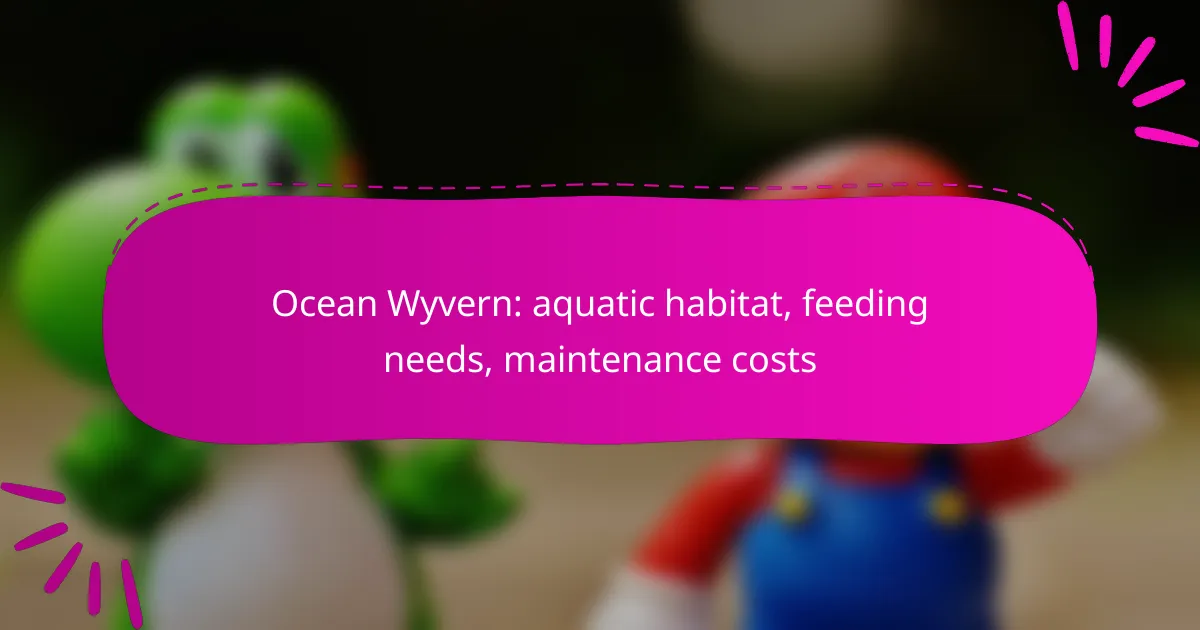Caring for a Cave Wyvern in underground habitats requires careful attention to their environmental needs, including temperature and humidity levels. Additionally, understanding the feeding costs and logistics of care is essential, as these creatures have specific dietary requirements that can impact monthly expenses. Proper habitat setup and essential supplies are vital for their health and well-being.

How to care for a Cave Wyvern in underground habitats?
Caring for a Cave Wyvern in underground habitats involves maintaining specific environmental conditions and providing adequate nutrition. Understanding their needs for temperature, humidity, and enrichment is crucial for their well-being.
Optimal temperature range
The optimal temperature range for a Cave Wyvern typically falls between 20°C to 25°C (68°F to 77°F). Maintaining this temperature is essential for their metabolism and overall health.
Use heating pads or heat lamps to achieve the desired warmth, but ensure there are cooler areas for the wyvern to retreat to if it gets too hot. Regularly monitor the temperature with a reliable thermometer.
Humidity requirements
Cave Wyverns thrive in humidity levels of around 60% to 80%. This high humidity helps prevent dehydration and supports their respiratory health.
To maintain adequate humidity, consider using a misting system or placing water bowls in their habitat. Regularly check humidity levels with a hygrometer to ensure they remain within the ideal range.
Substrate options
Choosing the right substrate is crucial for a Cave Wyvern’s comfort and health. Options like coconut fiber, peat moss, or a mix of both can provide a suitable environment.
Ensure the substrate is deep enough to allow for burrowing, as this behavior is natural for them. Regularly replace the substrate to prevent the buildup of waste and maintain hygiene.
Enrichment activities
Providing enrichment activities is vital for a Cave Wyvern’s mental stimulation. Incorporate climbing structures, tunnels, and hiding spots to encourage natural behaviors.
Rotate these enrichment items regularly to keep the environment engaging. You can also introduce safe toys or foraging opportunities to stimulate their curiosity and activity levels.
Health monitoring
Regular health monitoring is essential to ensure your Cave Wyvern remains healthy. Observe their eating habits, activity levels, and physical appearance for any signs of illness.
Schedule routine veterinary check-ups, ideally with a vet experienced in exotic pets. Keep a log of any changes in behavior or health to discuss during these visits.

What are the feeding costs for a Cave Wyvern?
The feeding costs for a Cave Wyvern can vary significantly based on its size, diet, and habitat. Generally, owners should expect to spend a moderate amount monthly, factoring in the specific nutritional needs of these creatures.
Average monthly food expenses
On average, the monthly food expenses for a Cave Wyvern can range from a few hundred to over a thousand dollars, depending on the quality and type of food provided. Budgeting around 500 to 800 USD is a reasonable starting point for most owners.
Costs can fluctuate based on availability and seasonality of certain food types, so it’s wise to monitor local market prices regularly.
Recommended diet types
Cave Wyverns thrive on a diet rich in protein, primarily consisting of small mammals, insects, and occasionally, fruits or vegetables for added nutrients. High-quality commercial reptile food can also be included to ensure balanced nutrition.
Consider sourcing fresh food from local suppliers to maintain quality and reduce costs. Avoid processed foods that may lack essential nutrients.
Feeding frequency
Feeding frequency for a Cave Wyvern typically ranges from two to three times a week, depending on its age and activity level. Younger Wyverns may require more frequent feedings to support their growth.
It’s crucial to observe the Wyvern’s body condition and adjust feeding schedules accordingly to prevent obesity or malnutrition. Always provide fresh water alongside meals to ensure proper hydration.

What supplies are essential for Cave Wyvern care?
Essential supplies for Cave Wyvern care include habitat setup materials, feeding equipment, and health care supplies. Each category plays a crucial role in ensuring the well-being and proper management of these unique creatures.
Habitat setup materials
Creating an appropriate habitat for Cave Wyverns requires specific materials that mimic their natural underground environment. Use sturdy enclosures that provide ample space for movement and climbing, along with substrates like soil or sand that facilitate burrowing.
Incorporate elements such as rocks, caves, and foliage to provide hiding spots and enrichment. Ensure proper ventilation and humidity control, as these factors are vital for their health and comfort.
Feeding equipment
Feeding Cave Wyverns necessitates specialized equipment to accommodate their dietary needs. Use durable feeding dishes that can withstand their strong jaws, and consider automatic feeders for consistency in meal timing.
Provide a variety of food options, including insects, small mammals, and specialized pellets, to ensure a balanced diet. Regularly monitor food intake and adjust portions based on their activity levels and growth stages.
Health care supplies
Maintaining the health of Cave Wyverns requires a range of health care supplies. Stock basic veterinary tools such as thermometers, scales, and first aid kits to address minor injuries or illnesses promptly.
Regular check-ups with a veterinarian familiar with exotic species are essential. Keep records of vaccinations and treatments to ensure compliance with any local regulations regarding exotic pet care.

What are the compatibility factors for Cave Wyverns?
Cave Wyverns have specific compatibility factors that influence their co-habitation with other species and their environmental needs. Understanding these factors is essential for ensuring a harmonious habitat and proper care logistics.
Co-habitation with other species
Cave Wyverns typically thrive in environments where they can coexist with certain species. They are generally compatible with other reptiles and some small mammals, but caution is advised with larger predators that may view them as prey. It is crucial to monitor interactions closely to prevent stress or aggression.
When introducing new species, consider starting with a small number and observing their behavior for compatibility. Avoid mixing species with vastly different dietary needs or territorial behaviors, as this can lead to conflict and stress.
Environmental compatibility
The environmental compatibility of Cave Wyverns is vital for their well-being. They prefer damp, dark habitats that mimic their natural underground environments, with temperatures typically ranging from 20°C to 25°C. Maintaining humidity levels between 60% and 80% is also important to prevent dehydration.
To create an optimal habitat, use substrates that retain moisture and provide hiding spots. Regularly check temperature and humidity levels to ensure they remain within the ideal range, as fluctuations can affect the health and behavior of the Cave Wyverns.

How do Cave Wyverns adapt to their underground environment?
Cave Wyverns have developed unique adaptations that enable them to thrive in dark, subterranean habitats. These adaptations include specialized behaviors and physiological traits that help them navigate, hunt, and survive in low-light conditions.
Behavioral adaptations
Cave Wyverns exhibit distinct behavioral adaptations that enhance their survival in underground environments. They often rely on echolocation to navigate through dark tunnels, emitting sounds that bounce off surfaces to create a mental map of their surroundings. This ability allows them to avoid obstacles and locate prey effectively.
Additionally, these creatures tend to be more nocturnal, hunting primarily during the night when their prey is most active. Their hunting strategies may include ambush tactics, where they remain still and wait for unsuspecting prey to pass by, taking advantage of their camouflage against rocky backgrounds.
Physiological adaptations
The physiology of Cave Wyverns is finely tuned for life underground. Their eyes are adapted to low-light conditions, often featuring a reflective layer that enhances night vision. This adaptation allows them to see in near darkness, which is crucial for spotting prey and avoiding predators.
Moreover, Cave Wyverns have developed a unique respiratory system that allows them to thrive in the often humid and stagnant air of caves. They can extract oxygen efficiently from the air, which is vital in environments where air quality may fluctuate. Their skin may also possess specialized glands that help regulate moisture levels, preventing dehydration in their dry subterranean habitats.










